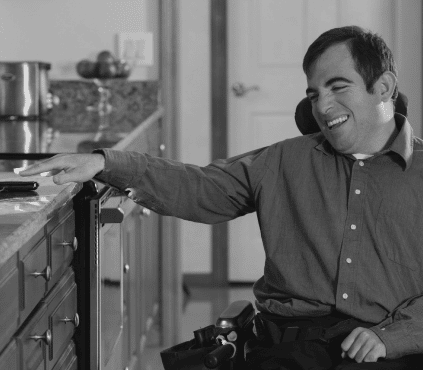Interacting With Police If You Have a Disability
Individuals with disabilities may walk, move, speak or behave differently from what law enforcement officers would deem as “normal.” Rather than consider a disability, they assume these individuals are intoxicated or uncooperative. Disabled individuals are not seeking special treatment. They simply wish to be treated with the same consideration as everyone else.
Were you or a loved one a victim of police brutality?
Attorneys that work with Police Brutality Center may be able to assist you.
"*" indicates required fields
Content Last Updated: March 3, 2025
Law enforcement officers are ill-equipped to interact with disabled individuals in a non-discriminatory fashion. This can be attributed to a lack of training as well as bias against disabled individuals. According to the Ruderman Foundation, the media has significantly stigmatized disability and underplayed its role in high-profile cases of police brutality.
As a result, approximately one-third to one-half of individuals killed by the police are disabled, and disabled individuals comprise the majority of high-profile use-of-force cases. Exact statistics are unavailable because there are no requirements to track how often force is used against individuals with disabilities.
Examples of high-profile cases of police killings in which underreported disabilities were involved include the following:
Freddie Gray
- Experienced cognitive disabilities due to lead poisoning
- Died in police custody due to a mysteriously
broken neck
Eric Gardner
- Suffered from severe asthma, heart disease, diabetes and sleep apnea
- Died in a police chokehold
Sandra Bland
- Suffered from severe depression and epilepsy
- Died in her jail cell in a death ruled a suicide
In all three of these cases, police failed to consider disabilities, and instead, the victims were blamed for their own deaths while the media failed to mention their disabilities or mentioned them in an inaccurate, stigmatizing context.
What are common problems from disabilities and interaction with law enforcement?

Complications are more likely to develop during interactions between police and people with disabilities because communication is hindered or police misjudge unexpected actions. While some disabilities are visible, many are not.
Interacting with individuals who have disabilities requires a measure of sensitivity and patience. Police officers operate on adrenaline and expect instantaneous compliance with their orders. Disabled individuals may be unable to instantly comply due to physical, sensory or other reasons.
Physical Disabilities
Physical disabilities that impact hearing, sight and mobility should be easily detectable, but police who operate on autopilot may not notice the signs or consider a disability.
Mobility Issues
People who rely on wheelchairs, walkers and canes for ambulation may be better positioned to experience the outrage of the community on their behalf because their disabilities are visible. However, this does not prevent the police from engaging in unjustified, brutal tactics. Those who rely on canes and walkers may experience suspicion by police when reaching for assistive devices. Even paralyzed individuals in wheelchairs face unwarranted scrutiny and brutality.
Brian Sterner
A 32-year-old quadriplegic, Brian Sterner was dumped from his wheelchair onto his face by a Hillsborough County, Florida, sheriff’s deputy who mistakenly assumed he was faking his need to be in a wheelchair, according to a news report by a local Fox News affiliate.
Nicholas Kincade
Nicholas Kincade was a 25-year-old paraplegic who was brutally shoved out of his wheelchair by a police officer after Mr. Kincade accidentally ran over his foot. Mr. Kincade was also charged with battery on a police officer for the incident, despite his explanation that he did not intentionally run over the officer’s foot. The charges were ultimately dropped against Mr. Kincade, but the officer was neither charged nor terminated, according to CBS News.
Hearing Impairment
Individuals with hearing impairment may appear to be noncompliant when they cannot hear the officer’s commands. The Center for Disability Rights reports that the deaf community has expressed grave concerns about police confrontations, especially in the wake of the police shootings of two men with hearing impairments.
- Daniel Harris was a deaf man who was shot by police at a traffic stop while attempting to communicate with officers using American sign language.
- Darnell Wicker was fatally shot by police for failing to comply with their commands, which he could not hear, while moving out of his girlfriend’s apartment.
- During a traffic stop, Pearl Pearson Jr. was beaten in the face by police to the point of suffering eye and brain damage while he attempted to reach for his disability placard, according to the Huff Post.
- He was also dragged from the vehicle, placed in a chokehold and beaten severely. His arm was torn from its socket.
- He did not know why police pulled him over, and they approached with guns drawn.
- Most likely, they had told him to exit the vehicle, but he could not hear them.
In all of these cases, police assumed the worst rather than considering a hearing impairment.
Sight Impairment
Individuals who are blind or have vision impairments may be unable to comply with officer commands due to being unable to see where an officer is pointing. If the police fail to identify themselves, a blind person may be unaware that they are dealing with the police.
This was the case for Steven Stairs, a legally blind man who believed he was being kidnapped when police tackled him from behind on a city street while he attempted to use a pay phone. The police mistook his folded-up cane for a weapon and failed to identify themselves, according to the CBC News report.
It is not uncommon for sight-impaired individuals to carry batons to assist with mobility, and police had already asked Mr. Stair’s wife and friend what the purpose of his baton was. Any aware person should have drawn the correct conclusion that Mr. Stair was sight-impaired.

Intellectual/
Developmental Disabilities (I/DD)
According to the Bureau of Justice Assistance, people with I/DD are often misjudged by police and the general public because their disabilities are invisible. Many do not have any physical characteristics. As a result, they are faced with the following difficulties:
- Overrepresentation in the criminal justice system
- Higher probability of being victimized in violent crimes
- Vulnerable to being taken advantage of as suspects due to being suggestible and in need of personal connections
I/DD includes but is not limited to the following:
- General intellectual disability
- Down syndrome
- Fragile X syndrome
- Cerebral palsy
- Autism spectrum disorders
- Fetal alcohol spectrum disorders
The Americans with Disabilities Act requires public agencies, including the police, to provide reasonable accommodations to individuals with disabilities. However, the police rarely recognize or acknowledge disabilities. Even when they are aware of the presence of a disability, they seldom accommodate it.
Disabled individuals faced with police demands, interrogations and detainment may be unable to comply with police when they are not properly accommodated. They may:
- Experience difficulty expressing themselves
- Be eager to please or easily influenced
- Desire and make serious efforts to hide their disability
- Be unresponsive or unable to understand verbal instructions
- Become overwhelmed
- Attempt to run away
- Have difficulty understanding their rights but pretend to understand
- Confess to crimes even though they are innocent
Cerebral Palsy
People with cerebral palsy may exhibit symptoms that lead uninformed police officers to believe they are under the influence of drugs or alcohol, such as an unusual gait, slurred speech and shakiness. Unfortunately, officers often fail to believe individuals who attempt to explain their disability to police officers, even with medical verification.
Garry Palmer of Tennessee, a 59-year-old man with cerebral palsy, was arrested and jailed for drunk driving and pressured by the prosecutor to plead guilty even after receiving medical verification from the doctor, according to Disability Scoop.

Autism
The autism spectrum is wide-ranging, and individuals on the spectrum may exhibit a wide variety of behaviors that could complicate interactions with the police. Pathfinders for Autism, an organization that provides support and guidance to autistic individuals, offers the following insights into specific actions and behaviors common to the various degrees of autism, which could be misinterpreted by law enforcement as aggressive or uncooperative.
- Self-soothing behaviors, such as fidgeting with an object in a pocket
- Running away
- Touching or trying to touch a police officer
- Standing too close

According to Autism Speaks, disabled individuals are seven times more likely than others to interact with police, and 53 percent of autistic adults in a 2019 study reported having had four or more interactions with police in their lifetime. Many reported that these experiences were negative due primarily to the lack of understanding of autism by police officers.
Multiple studies cited by Autism Speaks observed that the methods by which autistic adults respond to stress are often misunderstood by police. Autistic people often experience meltdowns when confronted with stress. Meltdowns are characterized by intense emotional reactions, which can result in a range of responses, including the following:
- Withdrawal
- Non-speaking
- Emotional outbursts including crying or other atypical behaviors
- Communication challenges
According to the Journal of Autism and Developmental Disorders, more than 5.4 million adults in the United States are on the autism spectrum. There is no excuse for law enforcement’s ignorance in working with autistic individuals.
When confronting individuals with autism, officers should be aware that the following behaviors are not combative, uncooperative or attempts to flee, according to Autism Speaks:
- Exhibiting an impaired sense of danger
- Wandering
- Feeling overwhelmed by police
- Fearing people in uniform
- Reaching for objects out of curiosity, such as shiny badges and handcuffs
- Exhibiting fight or flight responses
- Not responding to commands such as stop or to provide a name
- Delayed speech/language
- Avoiding eye contact
- Repetitive behavior like rocking
- Sensory perception issues
- Seizures
Fetal Alcohol Spectrum Disorders
Fetal alcohol spectrum disorder (FASD) is one of the most common neurodevelopmental disorders in the world, but it has a low level of awareness compared to other disabilities, according to Frontiers in Psychology. Individuals with FASD are often stigmatized as criminals and tend to come into contact with the criminal justice system more frequently.
Individuals with FASD may experience the following symptoms, according to the CDC, which could be used against them by law enforcement:
- Poor coordination
- Hyperactivity
- Difficulty with attention
- Poor memory
- Learning disabilities
- Speech and language delays
- Low IQ
- Intellectual disability
- Poor reasoning skills
- Poor judgment
- Vision or hearing difficulties

Down Syndrome
Ethan Saylor was a 26-year-old man with Down syndrome who was killed by police when he refused to leave a movie theater. The issue was that he wanted to watch a movie for the second time but did not have money to pay for a second ticket.
Three off-duty police officers were working in security positions and attempted to remove Ethan from the theater. They wrestled him to the ground and handcuffed him. Due to heart issues that are common to people with Down syndrome, Ethan was highly vulnerable. Ethan cried out for his “mommy” during the altercation. He had an IQ of 40, according to the report, and his aide had warned the police that he would not react well if he were touched. She also advised the officers that with a little patience, the situation could be resolved.
Ethan’s death was ruled a homicide by asphyxia. Ethan was not posing a danger to anyone. This was about wanting to sit and watch a movie, with a lack of understanding as to why he could not. Despite mishandling the situation on multiple levels, the officers involved were cleared of wrongdoing.

Mental Health Disorders
Mental health disorders are perhaps the most stigmatized disabilities that police are called to manage, and the results are especially fatal. Mental illness is not the same as I/DD and requires a different response. Due to the wide variety of mental illnesses, each case is unique, requiring a significant degree of sensitivity and patience.
Mental health issues can result in psychotic breaks, episodes of paranoia and acting out. This is common in individuals with schizophrenia and bipolar disorder. Individuals with diabetes, hypoglycemia and dementia may also exhibit these symptoms.
In many cases, family members call 911 seeking assistance or a welfare check, and police are dispatched to the scene. Rather than de-escalate, they shoot. According to a report by NBC News, black men with mental illness are more likely than white men to be shot and killed by police, even when they are exhibiting the same symptoms.
This indicates a problematic bias, with police viewing black men in mental health crises as a threat while viewing white men as individuals who need help. The report also found that black men are less likely to seek treatment for their diagnoses. This could be due to their inability to access unbiased health care and lower socioeconomic status.
How can poor outcomes be avoided?
The three primary solutions to avoiding these poor outcomes are:
- Mandatory police training in the recognition and management of disabilities
- Reducing police involvement in mental health crises
- Mandatory basic skills development for initial recognition and contact with disabled individuals
Officer Training
Officers must be trained to reduce the use of force when they encounter individuals with disabilities. Unnecessary use of force usually occurs when officers mistakenly perceive a mental health crisis as a danger to themselves or the general public. The following training can help reduce this:
- Awareness of common characteristics and behaviors associated with I/DD and mental health disabilities
- Interaction techniques with disabled individuals
- When and how to offer reasonable accommodations and modifications
- Sensitivity training that helps officers understand what disabled individuals experience
- Appropriate steps to improve communication
- How to avoid escalating interactions
- How to de-escalate individuals facing mental health crises
- An awareness of local resources for individuals with disabilities, including training in when and how to access them
- Training for dispatchers in how to appropriately communicate disability information with responding officers

The Crisis Intervention Team (CIT) Model
The Journal of the American Academy of Psychiatry and the Law recommends the CIT model, which was developed by the Memphis Police Department, as an effective approach to reduce contact between untrained police officers and individuals facing a mental health crisis:
- Specialized training for sworn police officers
- These officers would be dispatched when mental health calls are received
- Non-sworn police department employees with mental health training that can provide on-site or remote consultations and advice to officers in the field
- Coordination between police departments and mental health agencies
- Emergency response in the field with mental health professionals as the primary agents rather than law enforcement officers
- Mobile crisis units
- Street triage
- Neighborhood-based care coordination with mental health agencies
Pathway to Justice is a program offered by the Arc, the nation’s largest disability advocacy organization, which seeks to bring together law enforcement and disability professionals in order to facilitate greater access to justice for individuals with disabilities. This is accomplished through the following efforts:
- Building relationships between law enforcement and mental disability professionals in each community
- Providing support to each community in creating a multidisciplinary team called a Disability Response Team
- Providing full-day training for law enforcement officers and others on key topics such as how to identify, interact with and accommodate people with I/DD and mental health disabilities.
Tips for People Living With Disabilities When Interacting With Police
Police officers do not understand disabilities, and they may not be trained to recognize behavior that is common for people with disabilities. The following tips will prepare you to protect yourself when confronted by a police officer.
- Maintain a positive, cooperative attitude.
- Stay calm.
- Decide ahead of time what coping strategies you will use.
- Your coping strategies should not involve any actions the officer may perceive as a threat, such as hiding your hands or touching the officer.
- Roleplaying police interactions with a caregiver or close relative can help you to be prepared to keep yourself safe when talking to the police.
Telling the Police About Your Disability
One of the most effective ways to advise law enforcement about a disability is to carry a card in your pocket with information, such as the one developed by the state legislature in Illinois, according to WTTW News. The card should list the following information:
- Your diagnosis
- Behaviors police officers should expect
- A statement that these behaviors are not a refusal to cooperate
- Contact information for an advocate or relative
The Wallet Card is a free service that provides a customized card to teens and adults living with autism or intellectual disabilities who are verbal enough to state that they have the card.
If you carry the card in your pocket, purse or vehicle, make sure you obtain the officer’s permission to retrieve it before reaching for it. If you do not have a card, it is still important to inform the officer that you have a disability, what accommodations you will need, how your disability may impact the interaction and contact information for your advocate or relative.

How Caregivers Can Assist
Caregivers can help prevent interactions with police from escalating by educating and preparing disabled individuals for possible interactions ahead of time. The Easter Seals provide the following tips to accomplish this:
- Introduce the individual to police in a neutral setting.
- Educate the individual about what could happen in a police interaction and appropriate responses.
- Work on a continuous basis to build trust and respect between the disabled individual and local law enforcement officers.
During a police interaction involving disabled individuals, Pathways for Autism offers the following tips for caregivers to ensure the interaction goes smoothly without escalating:
- Allow police to address the individual.
- If the individual is nonverbal, advise the police of this and instruct the officer in the most effective communication methods.
- Maintain a non-threatening demeanor and make it clear that you are only there to assist with communication.
- Provide the officer with a list of triggers and effective methods for de-escalating the individual.

Other Possible Solutions
The Vitals app is a tool that first responders can use to access information provided by the family about an individual’s disabilities and medical needs. To use the app, the individual would need to wear a beacon, such as a necklace, and police departments that use the app can access the information, which is provided by the family. The family could include information such as the following:
- Triggers
- Effective communication methods
- Effective de-escalation techniques
- Behaviors to expect
- Emergency contact information
This app is used by the Plymouth, Minnesota, police department. In one incident, a woman had parked her car in an unusual area in response to her usual route home being barricaded. Police thought this behavior was strange. The Vitals app explained that she was autistic and did not know another route home. The officer was able to use the information to contact her family and help her get home safely.
How To Interact With Police If You Have an Intellectual/
Developmental Disability
Police officers may not be aware of your disabilities, and they may not know how to communicate with you in a way that is comfortable and effective. Untrained police officers may trigger individuals with the following disabilities (not an exhaustive list):
- Autism spectrum disorder
- Down syndrome
- Fetal alcohol spectrum disorder
- Mental health disabilities
- Cerebral palsy
- Attention deficit disorder
- Neurological disabilities
Due to their lack of training, police may also misinterpret your actions as hostile or uncooperative. When talking to the police, the following strategies will help you to stay safe:
- Keep your hands out of your pockets and where officers can see them.
- Never reach for your pocket without first getting the officer’s permission.
- Drop anything in your hands.
- Tell the police officer about your diagnosis and request that the police contact your advocate or family member.
- If officers attempt to question you without your advocate present, politely inform the officer that you would like to wait for your advocate to arrive before you answer any questions. This is your right.
- Follow directions the first time asked.
- Anticipate that police may touch you and use coping strategies if necessary.
- Do not run away from the police officer.
- Do not touch the police officer, their possessions or police dogs.
- If asked if you understand, politely tell the police officer if you do not understand.
Possible Actions from People Who Have an Intellectual/
Developmental Disability
The Department of Justice advises police officers not to interpret the following actions from people with I/DD as a lack of cooperation or a threat:
- Running away
- Stimming – repetitive coping behaviors such as rocking, hand-flapping or repetition of words or phrases
- Failing to immediately follow instructions
- Failing to make eye contact or look at an officer in the face
- Failing to understand or pretending to understand rights or instructions
- Quickly and easily confessing to a crime
- Hesitating to report victimization or other events

What Officers Should Know About Serving People With These Conditions
The Rocky Mountain ADA Center provides the following guidance to police about serving individuals with disabilities:
- Patience and understanding are key to successful interactions.
- Individuals with I/DDs vary in their level of functioning and coping mechanisms.
- Intellectually and developmentally disabled individuals may be triggered by everyday occurrences such as flashing lights, a uniform, loud noises and being touched.
- Being triggered does not make these individuals a threat.
- Removing the trigger is an important step in calming a disabled individual.
- Relying on a caregiver or family member for effective calming strategies can help calm the individual as quickly as possible.
- Individuals with I/DDs may have impaired language and communication skills, and this can be worsened if they are frightened.
- Individuals with I/DDs have a tendency to hide or retreat as a matter of reflex when triggered, but this does not mean they are intentionally fleeing or refusing to cooperate.
- Use simple language and focus on building rapport.
- Avoid rushing the interaction, using slang, appearing impatient or treating the individual like a child.
- Frequently ensure the individual understands and avoid second-guessing the individual’s answers.
According to the Arc, disabled individuals are the largest minority group in the United States, and officers who are trained to work with them have an advantage over other officers. In addition:
- Abiding by the ADA decreases liability and builds trust between the community and law enforcement.
- Proactive policies, such as community policing, are more effective than crisis intervention.
- The responsibility of building safer communities should be a shared responsibility, not just a law enforcement responsibility.
Overall, the most effective approach to working with disabled individuals involves the following philosophies:
- Conversation instead of force
- Questions instead of commands
- Patience instead of immediate demands
Rights During an Arrest for Those With Disabilities
According to the U.S. Department of Justice, Title II of the ADA requires police officers to accommodate disabled individuals during all of the following law enforcement activities unless the individual is truly presenting a direct threat:
- Street interactions
- Responding to complaints
- Calls for assistance
- Traffic stops
- Searches
- Arrests
- Detentions
- Interviews
- Interrogations
- Emergency responses
Title II of the ADA entitles individuals with disabilities to equal treatment.
- Officers must be trained not to arrest individuals with mental health disabilities or I/DD for offenses they would not arrest anyone else for.
- Officers must provide reasonable accommodations and modifications to individuals with disabilities when necessary to ensure equal treatment and access to services.
- Train officers to provide time and space to disabled individuals who do not present a threat to public safety.
- Train officers in de-escalation techniques.
- Train officers to dispatch professional crisis intervention teams or trained mental health professionals to manage mental health crises.
- Law enforcement must take appropriate steps to ensure communication with people with disabilities is as effective as communication with non-disabled individuals.


